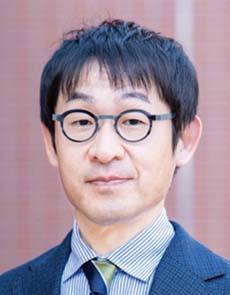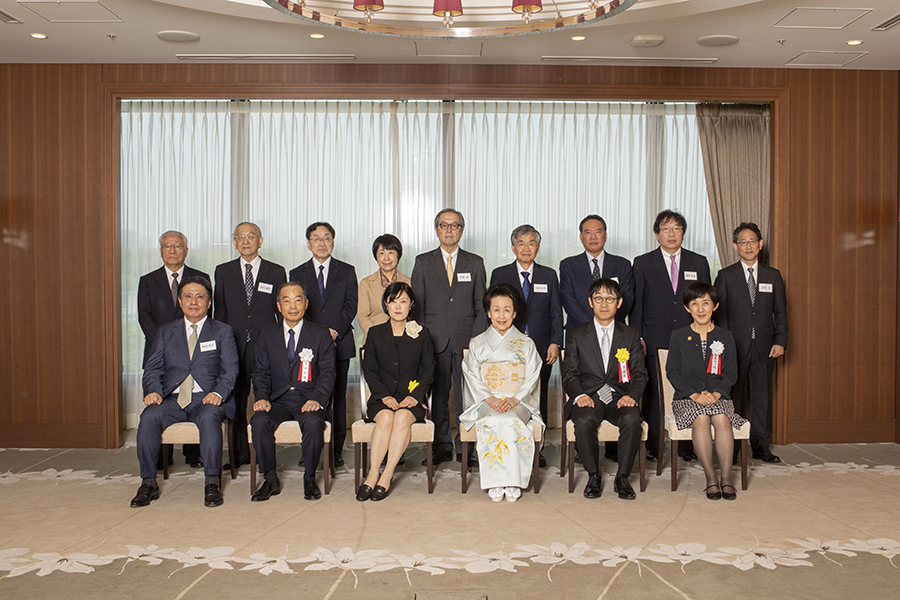2025年比較腫瘍学常陸宮賞受賞者
The Awardee of the 2025 Prince Hitachi Prize for Comparative Oncology
Studies on mechanisms of cancer regulation by cell-cell competition and cooperation
細胞の競合と協調によるがん制御機構の解明

Tatsushi Igaki
Professor,
Laboratory of Genetics, Graduate School of Biostudies, Kyoto University
井垣 達吏 博士
京都大学大学院生命科学研究科 教授
略歴
井垣達吏博士は、1970 年に岡山県岡山市に生まれ、1993 年3 月に岡山大学薬学部薬学科を卒業した。同年4 月に同大学薬学研究科修士課程に進学し、早津彦哉教授および綿矢有佑助教授のもとで「抗がん剤による細胞死誘導過程で活性化される核酸分解酵素」に関する研究に従事し、1995 年3 月に修士号を取得した。1995 年4 月より杏林製薬(株)中央研究所にて研究に従事したのち、1999 年4 月に大阪大学大学院医学系研究科博士課程に進学し、三浦正幸助教授のもとで「ショウジョウバエにおける細胞死実行機構」の研究を行い2003 年3 月に博士号(医学)が授与された。2003 年7月より米国イェール大学医学部Tian Xu 博士の研究室に留学し、ショウジョウバエを用いたがん進展メカニズムの研究を開始した。このとき、ショウジョウバエ上皮組織においてがん原性の変異細胞が野生型細胞に囲まれると細胞死を起こして排除される「細胞競合」現象を見いだした。2007 年11 月に神戸大学大学院医学研究科 テニュアトラック独立特命助教に就任し、自身の研究室を主宰。2009 年10 月に同研究科特命准教授、2012 年4 月に同研究科准教授、2013 年3 月に京都大学大学院生命科学研究科教授となり、この間一貫してショウジョウバエを用いた「細胞の競合と協調によるがん制御の分子機構」に関する研究を推進してきた。日本細胞生物学会会長(2022 〜2023 年)、学術変革領域研究「競合的コミュニケーションから迫る多細胞生命システムの自律性」(2021 〜2025 年度)領域代表者、革新的先端研究開発支援事業 (AMED-CREST)「根本的な老化メカニズムの理解と破綻に伴う疾患機序解明」(2022 〜2027 年度)研究代表者等を歴任。日本学術振興会賞(2014 年)、SGH 特別賞(2017 年)、JCA-Mauvernay Award(2018年)、井上学術賞(2019 年)、大阪科学賞(2020 年)等を受賞している。
Personal History Outline
Dr. Tatsushi Igaki was born in Okayama City, Japan in 1970. He graduated from the Faculty of Pharmaceutical Sciences at Okayama University in March 1993. He then entered the Master's program in the Graduate School of Pharmaceutical Sciences at Okayama University, where he conducted research under the supervision of Professor Hikoya Hayatsu and Associate Professor Yusuke Wataya on "Nuclease activated during anticancer drug-induced cell death", receiving his Master's degree in March 1995. He then joined the Central Research Institute of Kyorin Pharmaceutical Co., Ltd. in April 1995, where he engaged in pharmaceutical research. In April 1999, he entered the doctoral program at the Graduate School of Medicine, Osaka University, and started research on "the mechanism of cell death in Drosophila" under the supervision of Associate Professor Masayuki Miura, earning his Ph.D. in Medicine in March 2003. In July 2003, Dr. Igaki moved to the United States to conduct postdoctoral research in the laboratory of Dr. Tian Xu at Yale University School of Medicine. There, he began studying the mechanisms of cancer progression using Drosophila as a model organism. During this period, he discovered the phenomenon of "tumor-suppressive cell competition," in which oncogenic mutant cells are eliminated via cell death when surrounded by wild-type cells in Drosophila epithelial tissue. In November 2007, he was appointed as a tenure-track Specially Appointed Assistant Professor at the Graduate School of Medicine, Kobe University, where he started his own research group. He was promoted to Specially Appointed Associate Professor in October 2009 and to Associate Professor in April 2012. In March 2013, he became a Professor at the Graduate School of Biostudies, Kyoto University. From the time he began leading his own laboratory, he has focused his research on elucidating the molecular mechanisms of tissue homeostasis and cancer regulation via cell-cell competition and cooperation, using Drosophila as a model organism. Dr. Igaki has served as President of the Japan Society for Cell Biology (2022–2023), Research Area Lead of the Grant-in-Aid for Transformative Research Areas (A) “Understanding multicellular autonomy by competitive cell-cell communications” (2021–2025), and Principal Investigator of the AMED-CREST “Bridging the fundamental mechanism of aging and the effective treatment of age-related disease associated with impaired functional system” (2022–2027). His honors include JSPS Prize (2014), SGH Special Award (2017), JCA-Mauvernay Award (2018), Inoue Prize for Science (2019), and the Osaka Science Prize (2020).
受賞対象となった研究業績
細胞の競合と協調によるがん制御機構の解明
井垣達吏博士は、米国イェール大学に博士研究員として留学していた際(2003 年〜2007 年)、ショウジョウバエの上皮組織の中にがん細胞の芽(がん原性細胞)を誘導してもがんには進展しないことを見いだし、この現象の中に積極的ながん抑制メカニズムが存在することを発見した。2007 年11 月に神戸大学にて独立後、この現象の分子機構をショウジョウバエ遺伝学を用いて解明しようとするユニークな研究を開始した。その結果、「細胞競合」と呼ばれる現象ががんの制御に重要な役割を果たすという
驚くべき事実を世界に先駆けて発見した。細胞競合は、1975 年に当時スペインの大学院生であったGinés Morata とPedro Ripoll によって見いだされた現象であるが、その後あまり注目されることなく長らく埋もれていた。井垣博士が見いだした「細胞競合を介したがん細胞制御機構」の存在は、細胞競合を生命科学研究の檜舞台に引き出す1つの契機となり、井垣博士らによるその後の一連の分子機構解明は、基礎生物学およびがん生物学に多大なインパクトを与えるものとなった。
具体的には、井垣博士はまず、正常細胞と変異細胞の相互作用をショウジョウバエの生体内で解析できる「遺伝的モザイク法」を用いて、細胞極性が崩壊したがん原性変異細胞は通常は腫瘍化するが、正常細胞に近接すると細胞死を起こして組織から消失することを見いだした。この現象をさらに追跡し、極性が崩壊したがん原性細胞は正常細胞に囲まれるとTNF-JNK シグナルを介して組織から排除されることを明らかにした。井垣博士のこの発見は、上皮組織にはがん原性細胞を細胞競合によって積極的に排除する「組織内在性のがん抑制機構」が存在することを世界に先駆けて提示するものとなった。続けて井垣博士は、この細胞競合の一連の分子メカニズムを解明していった。まず、がん原性細胞に近接する正常細胞(勝者細胞)はJNK シグナルを介して貪食能を亢進し、近接細胞の排除を促進することを見いだした。2013 年からは京都大学に研究室を移動し、正常細胞に囲まれたがん原性細胞がJNK 依存的に細胞間反発シグナル(Slit-Robo シグナル)を活性化して上皮層から排除されやすくなることを明らかにした。さらに、大規模な遺伝学的スクリーニングにより、正常細胞ががん原性細胞を認識するための細胞表面リガンドSas およびその受容体チロシンホスファターゼPTP10D を同定し、正常細胞とがん原性細胞の境界面で起こるシグナル伝達メカニズムを解明した。この発見は、細胞競合の勝者と敗者の直接的な相互作用を分子レベルで解明する世界初の成果となった。PTP10D のヒトホモログ分子PTPRJ は
がん抑制遺伝子として機能することから、同様の細胞競合機構がヒトのがんにおいても働いていることが示唆される。続いて井垣博士は、この細胞競合の活性が自然免疫シグナルによって制御されること、また生体内の高インスリン血症がこの細胞競合を抑制してがん化を促進することを発見し、肥満や糖尿病で細胞競合が抑制されてがんが発生するという新たな仕組みを提示した。さらに、細胞競合の敗者でオートファジーを介した細胞死誘導が起こることを発見し、細胞競合における敗者の消失機構の主要部分の1つを解明した。
これらの研究と並行して、井垣博士は細胞競合の破綻によって起こる「細胞間協調」によるがん発生・悪性化機構の解析を進め、がん遺伝子Ras の活性化とミトコンドリア機能障害(いずれもヒトのがんで高頻度に認められる変異)によって細胞間協調を介したがん進展が起こること、またこの現象を駆動する細胞老化を介したSASP 機構を解明するとともに、がんを進展させる細胞老化の制御機構を明らかにした。また、がん遺伝子Src の活性化が周辺細胞のがん化を促進する現象を発見し、Src を起点とした細胞間協調によるがん進展機構を解明した。
ショウジョウバエをモデル生物として用いた井垣博士のこれら一連の先駆的成果は、細胞間コミュニケーションを介したがん制御機構の遺伝学的研究という新たな世界の潮流を生み出した。また、その独創的アプローチと普遍的な生物学的コンセプトから、哺乳類モデルも含めた「細胞の競合と協調によるがん制御」という新たな研究領域を確立し、比較腫瘍学研究の新たな地平を拓くものとなった。
Academic Achievement Related to this Award
Studies on mechanisms of cancer regulation by cell-cell competition and cooperation
During his postdoctoral training at Yale University School of Medicine (2003–2007), Dr. Tatsushi
Igaki discovered that oncogenic cells induced in Drosophila epithelial tissues do not develop into
tumors. This led him to uncover the existence of an active tumor-suppressive mechanism within the
epithelium. Upon starting his own laboratory at Kobe University in November 2007, he launched a
unique research project for elucidating the mechanism behind this phenomenon using Drosophila
genetics. As a result, he discovered that a phenomenon known as ‘cell competition’ plays a critical role
in the regulation of cancer. Although cell competition was first discovered in 1975 by Ginés Morata and
Pedro Ripoll, it received little attention for many years. Dr. Igaki’s identification of a tumor-suppressive
mechanism of cell competition brought new attention to this field. His subsequent elucidation of its
molecular mechanisms has had a profound impact on both basic biology and cancer research.
Dr. Igaki employed a genetic mosaic technique in Drosophila that allows the in vivo analysis of
interactions between normal and mutant cells. He found that clones of oncogenic cells in Drosophila
epithelium bearing mutations in apicobasal polarity genes, which are typically tumorigenic, undergo cell
death and are eliminated when surrounded by wild-type cells. He further demonstrated that such
oncogenic cells are eliminated via TNF-JNK signaling when surrounded by normal cells, thereby
revealing the existence of an intrinsic tumor-suppressive mechanism via cell competition within
epithelia.
Building on this discovery, Dr. Igaki explored the molecular mechanisms underlying cell competition.
He revealed that normal “winner” cells adjacent to oncogenic “loser” cells enhance their phagocytic
activity via JNK signaling to eliminate their neighbors. After relocating his lab to Kyoto University in
2013, he found that oncogenic cells activate the Slit-Robo repulsive signaling pathway in a JNKdependent
manner, making them more susceptible to exclusion from epithelium. Through a large-scale
genetic screen in Drosophila, he identified Sas, a ligand on normal cells, and PTP10D, a receptor
tyrosine phosphatase on oncogenic cells, as key players in the recognition of oncogenic cells. This was
the first study to elucidated the direct molecular interaction between winners and losers in cell
competition. Given that human ortholog PTP10D, PTPRJ, acts as a tumor suppressor, his findings
suggest that similar mechanisms may also apply in human cancer regulation.
Dr. Igaki also uncovered that the activity of cell competition is regulated by innate immune signaling,
and that hyperinsulinemia suppresses this process, promoting tumor progression. This led to a novel
concept in which conditions such as obesity and diabetes impair cell competition and thereby increase
cancer risk. Furthermore, he demonstrated that autophagy-mediated cell death occurs in loser cells,
revealing a core mechanism of their elimination.
In parallel, Dr. Igaki investigated how disruption of cell competition can lead to cancer progression
through “cell-cell cooperation.” He demonstrated that oncogenic Ras activation and mitochondrial
dysfunction, common cellular changes observed in human cancers, promote tumor growth and
metastasis through cell-cell interaction. He also elucidated the role of cellular senescence and the
senescence-associated secretory phenotype (SASP) in driving this cell-cell cooperation. In addition, he
discovered that activation of the oncogene Src enhances tumorigenesis in neighboring cells, further
uncovering a novel form of cancer progression driven by cell-cell cooperation.
Dr. Igaki’s pioneering studies using Drosophila as a model organism have opened new frontiers in
cancer biology by establishing a genetic framework for understanding tumor regulation through cell-cell
communication. His innovative approach and universal biological insights have established a new
paradigm for studying cancer: one that explores how cell-cell competition and cooperation shape cancer
progression across species, thereby expanding the horizons of comparative oncology.
Bibliography (Selected):
1. Taniguchi K, Igaki T: Sas-Ptp10D shapes germ-line stem cell niche by facilitating JNK-mediated apoptosis. PLOS Genetics 19, e1010684 (2023)
2. Nagata R, Akai N, Kondo S, Saito K, Ohsawa S, Igaki T: Yorkie drives supercompetition by non-autonomous induction of autophagy via bantam microRNA in Drosophila. Current Biology, 32, 1064-1076 (2022)
3. Wang Z, Xia X, Li J, Igaki T: Tumor elimination by clustered microRNAs miR-306 and miR-79 via noncanonical activation of JNK signaling. eLife 11, e77340 (2022)
4. Enomoto M, Takemoto D, Igaki T: Interaction between Ras and Src clones causes interdependent tumor malignancy via Notch signaling in Drosophila. Developmental Cell, 56, 2223-2236 (2021)
5. Ito T, Igaki T: Yorkie drives Ras-induced tumor progression by microRNA-mediated inhibition of cellular senescence. Science Signaling 14, eaaz3578 (2021)
6. Ochi N, Nakamura M, Nagata R, Wakasa N, Nakano R, Igaki T: Cell competition is driven by Xrp1-mediated phosphorylation of eukaryotic initiation factor 2α. PLOS Genetics 17, e1009958 (2021)
7. Cong B, Nakamura M, Sando Y, Kondo T, Ohsawa S, Igaki T: JNK and Yorkie drive tumor malignancy by inducing L-amino acid transporter 1 in Drosophila. PLOS Genetics 17, e1009893 (2021)
8. Akai N, Ohsawa S, Sando Y, Igaki T: Epithelial cell turnover ensures robust coordination of tissue growth in Drosophila ribosomal protein mutants. PLOS Genetics 17, e1009300 (2021)
9. Wada Y, Ohsawa S, Igaki T: Yorkie ensures robust tissue growth in Drosophila ribosomal protein mutants. Development 148, dev198705 (2021)
10. Sanaki Y, Nagata R. Kizawa D, Leopold P, Igaki T: Hyperinsulinemia drives epithelial tumorigenesis by abrogating cell competition. Developmental Cell 53, 379-389 (2020)
11. Nagata R, Nakamura M, Sanaki Y, Igaki T: Cell competition is driven by autophagy. Developmental Cell, 51, 99-112 (2019)
12. Katsukawa M, Ohsawa S, Igaki T: Serpin facilitates tumor-suppressive cell competition by blocking Tollmediated Yki activation in Drosophila. Current Biology, 28, 1756-1767 (2018)
13. Cong B, Ohsawa S, Igaki T: JNK and Yorkie drive tumor progression by generating polyploid giant cells in Drosophila. Oncogene 37, 3088-3097 (2018)
14. Yamamoto M, Ohsawa S, Kunimasa K, Igaki T: The ligand Sas and its receptor PTP10D drive tumoursuppressive cell competition. Nature, 542, 246-250 (2017)
15. Vaughen J, Igaki T: Slit-Robo repulsive signaling extrudes tumorigenic cells from epithelia. DevelopmentalCell, 39, 683-695 (2016)
16. Nakamura M, Ohsawa S, Igaki T: Mitochondrial defects trigger proliferation of neighbouring cells via
senescence-associated secretory phenotype in Drosophila. Nature Communications, 5, 5264 (2014)
17. Enomoto M, Igaki T: Src controls tumorigenesis by JNK-dependent Hippo pathway regulation in Drosophila. EMBO Reports, 14, 65-72 (2013)
18. Ohsawa S, Sato Y, Enomoto M, Nakamura M, Betsumiya A, Igaki T: Mitochondrial defect drives nonautonomous tumour progression via Hippo signalling in Drosophila. Nature, 490, 547-551 (2012)
19. Ohsawa S, Sugimura K, Takino K, Xu T, Miyawaki A, Igaki T: Elimination of oncogenic neighbors by JNKmediated engulfment in Drosophila. Developmental Cell 15, 315-328 (2011)
20. Igaki T, Pastor-Pareja JC, Aonuma H, Miura M, Xu, T: Intrinsic tumor suppression and epithelial maintenance by endocytic activation of Eiger/TNF signaling in Drosophila. Developmental Cell 16, 458-465 (2009)
21. Igaki T, Pagliarini R, Xu T: Loss of cell polarity drives tumor growth and invasion through JNK activation in Drosophila. Current Biology 16, 1139-1146 (2006)
22. Igaki T, Kanda H, Yamamoto-Goto Y, Kanuka H, Kuranaga E, Aigaki T, Miura M: Eiger, a TNF superfamily ligand that triggers the Drosophila JNK pathway. EMBO J. 21, 3009-3018 (2002)
23. Igaki T, Kanuka H, Inohara N, Sawamoto K, Nunez G, Okano H, Miura M: Drob-1, a Drosophila member of the Bcl-2/CED-9 family that promotes cell death. Proc. Natl. Acad. Sci. USA 97, 662-667 (2000)


